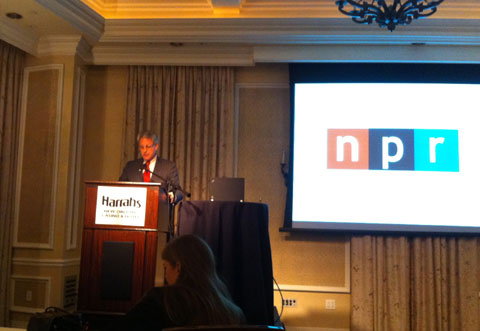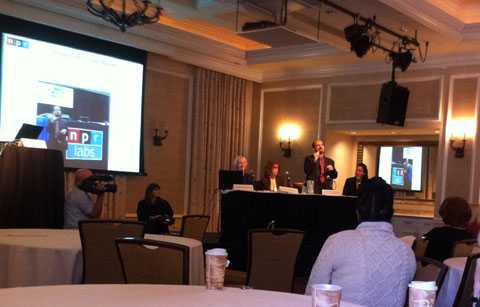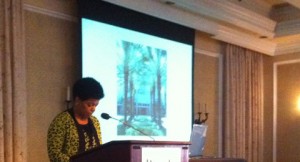What we talk about when we talk about public media

Gary Knell, NPR CEO, talking about public radio’s service to the American public, made possible through the power of local stations combined with national capacity.
If you’ve been following my blog posts to and from the public radio conference in New Orleans, you’ve probably noticed that I haven’t talked much about what we talked about there. You’ve heard about my train ride, about food and music, but not much from the public radio/media conference itself. I’m going to summarize the highlights here…and try to make it reasonably interesting. The conference was generally very positive. We met some new leaders at NPR and elsewhere around the public system, and I thought my colleagues were enthusiastic and optimistic in spite of challenges we all face.

Presentation by a faculty member from the Helen Keller School about radio for the blind AND deaf. So cool.
Some of the best sessions were the sidebar or niche presentations that took place. Mike Starling, who heads up the NPR Labs team that develops and applies new technologies, did an amazing presentation with people from the deaf/blind community. Yes, radio for the deaf, and even for those who are both deaf and blind is on the verge of roll out!
Here are the big takeaways in no particular order:
1. Collaboration
We have to play better with each other and with other media and news entities in our communities if we are going to provide the best possible public media service for the American public.
The Corporation for Public Broadcasting is setting aside a pool of money to help jumpstart collaborative undertakings, as well as full-blown consolidations. There are two outcomes that appropriate, case by case shaped collaborations can achieve: money savings across our public media system, and increased capacity at individual stations. Imagine, for example, several stations joining assets to create a regional service and/or working with local newspapers to extend the reach of all journalists.
I test NCPR against these goals and I think we’re doing well. Certainly our network of stations, built up over the last 25 years, has created an economy of scale for public radio service to the Adirondack North Country. And, more recently, we are seeking–and finding–partners and collaborative opportunities with others in journalism and media in our region. For example, working on investigative pieces and short series with reporters at the Adirondack Daily Enterprise.
2. Financial Sustainability
Optimism for long-term sustainability is based on our capacity to collaborate on the creation and distribution of content, and on our willingness to seek financial support collectively. I think the moment has come when we will see stations or groups of stations stepping up to work with national organizations, like NPR, to find new financial resources for our system.
Again, testing NCPR…one of our dearest friends, Margot Ernst, who served as a co-chair for NCPR’s Adirondack News Bureau Endowment campaign, has just been invited to join NPR’s Foundation Board. She joins our Executive Council member Steve Hopkins on that Board. This means we have people who are positioned to connect local, regional and national fundraising and resource-expansion efforts. (Congratulations to Margot!)

Karen Dunbar, CEO of the Poynter Institute, one of the leading training centers for journalists. Poynter often provides leadership on ethics and best practices for all of us.
3. Ethics and Journalistic Standards
As public media becomes an increasingly important source of news and information for the American public, stations and national organizations are scrutinizing and refining the practices that guide our work. For those of you who have followed this blog for some time, you know I introduced the issue of ethics and best practices about a year ago. We expect to share with you a revised and retooled ethics “handbook” for NCPR employees in the very near future.
Tags: ethics, journalism, poynter institute, public radio







